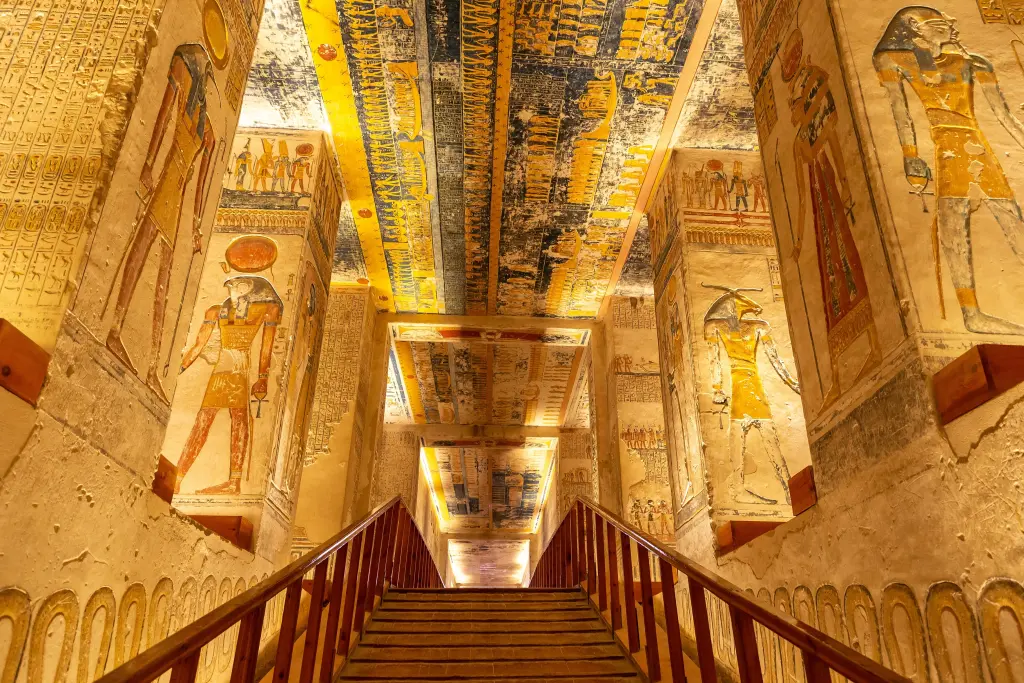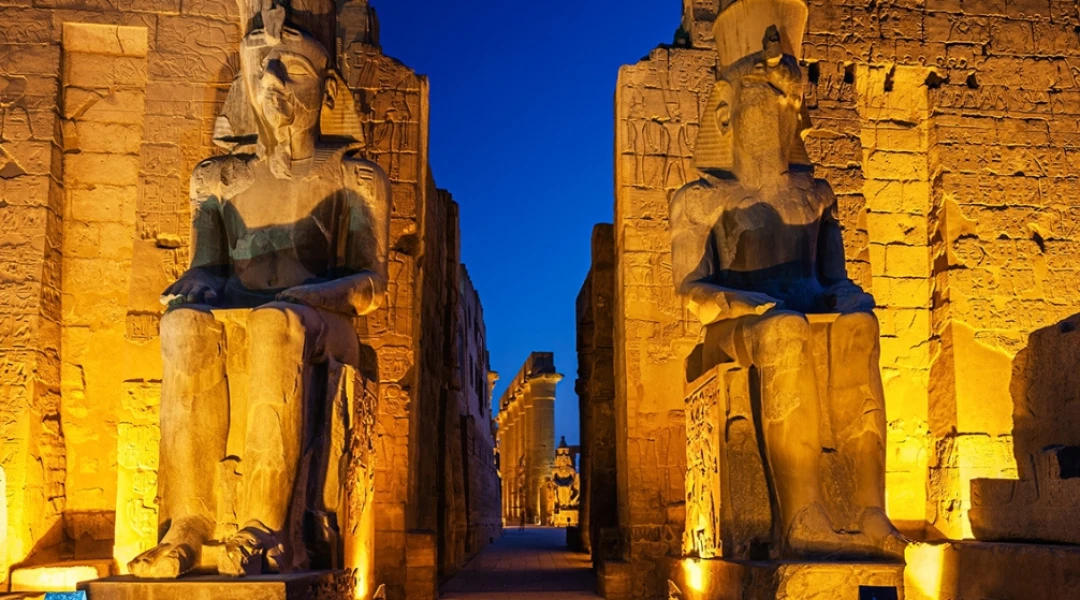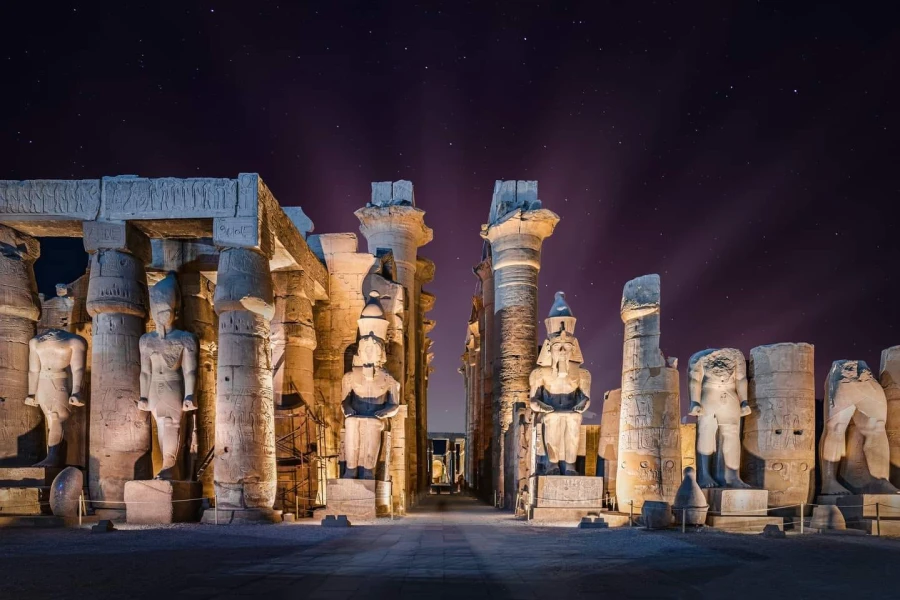Luxor the Ancient City
Luxor, Egypt, remains a door to the old marvels of the Pharaonic period. Spend your holiday with Luxor Day Tours. From great sanctuaries to regal burial chambers, here's a nitty gritty investigation of Luxor's rich social and verifiable fortunes.
Karnak Sanctuary Complex
Karnak Sanctuary Complex is an extensive old Egyptian sanctuary devoted principally to the Theban group of three Amun, Mut, and Khonsu. Situated on Luxor's east bank, it became a huge strict focus and a point of convergence for love and regal services.
Key Highlights:
- Extraordinary Hypostyle Lobby: One of the most noteworthy design accomplishments of old Egypt, the Incomparable Hypostyle Corridor is a huge lobby with 134 transcending segments, some arriving at levels of 23 meters. The segments are unpredictably decorated with pictographs and reliefs portraying the tactical missions and strict customs of the pharaohs.
- Pillars and Sculptures: Karnak is famous for its transcending monoliths, including the tallest enduring antiquated Egyptian monolith, initially raised by Hatshepsut. The complex is additionally home to various gigantic sculptures of pharaohs and divine beings, showing the heavenly and natural powers adored by the old Egyptians.
- Hallowed Lake: An essential piece of the sanctuary perplexing, the Holy Lake filled both reasonable and ceremonial needs. It was utilized for cleansing customs and as a reflection pool for stately purposes, stressing the otherworldly meaning of water in old Egyptian strict practices.
- Sanctuary Regions: Karnak is not a solitary sanctuary however an immense complex of sanctuaries, houses of prayer, arches, and different designs worked for more than a few centuries by progressive pharaohs, each transforming the sacrosanct grounds. The complex mirrors the developing strict convictions and political desires of the pharaohs who added to its development.
- Celebration Corridor of Tuthmosis III: A stupendous construction inside the perplexing, committed to facilitating fabulous strict celebrations and services during the New Realm time frame. Its loftiness and engineering complexity highlight Karnak's job as a focal point of strict and regal power in old Egypt.

Luxor Sanctuary
Luxor Sanctuary, arranged on the east bank of the Nile Waterway in Luxor, Egypt, is a demonstration of the greatness and strict meaning of old Egyptian engineering. Constructed essentially during the New Realm time frame, it was devoted to the revival of sovereignty and the worship of the god Amun.
Key Highlights:
- Road of Sphinxes: The way to deal with Luxor Sanctuary was fixed with sphinx sculptures, making a great stately pathway connecting it with Karnak Sanctuary more than 3 kilometers away. Unearthings and rebuilding endeavors have uncovered segments of this old road, offering guests a brief look into the terrific professional courses of old Egypt.
- Yard and Corridor: After entering the sanctuary complex, guests experience an enormous patio encompassed by corridors embellished with mind-boggling symbolic representations and reliefs. These portray scenes of illustrious customs, strict services, and contributions to the divine beings, giving bits of knowledge into the strict practices and convictions of antiquated Egyptians.
- Hypostyle Corridor: Like Karnak Sanctuary, Luxor Sanctuary includes a hypostyle lobby with huge segments decorated with cut pictographs and reliefs. This corridor filled in as a scene for strict parades and services, featuring the significance of ceremonial spaces in old Egyptian sanctuaries.
- Safe-havens and Churches: Inside Luxor Sanctuary are a few safe-havens and houses of prayer devoted to different divine beings and pharaohs. The most noticeable is the asylum of Amun, where sculptures and contributions were housed to respect the key god of Thebes.
- Later Augmentations: Throughout the long term, Luxor Sanctuary was extended and adjusted by progressive pharaohs, including Amenhotep III, Ramses II, and Alexander the Incomparable, each leaving their structural and strict engraving on the sanctuary complex.

Valley of the Kings in Luxor
The Valley of the Kings, situated on the west bank of the Nile close to Luxor, is perhaps Egypt's most well-known archeological site. It filled in as the graveyard for pharaohs and strong aristocrats during the New Realm time frame (roughly sixteenth to eleventh century BC). Here are a few insights regarding this wonderful site:
- Verifiable Importance: The Valley of the Rulers was picked as an internment site because of its disconnected area and regular pyramid-formed mountains that were accepted to be defensive. It supplanted the previous practice of pyramid assembling and was intended to protect intricate burial places from burial place burglars.
- Burial chambers: There are more than 60 burial places found in the Valley of the Lords, changing in size and intricacy. These burial chambers were carefully enlivened with intricate pictographs, scenes from Egyptian folklore, and perplexing works of art portraying the excursion of the departed into existence in the wake of death.
- Well-known Burial places: Among the most renowned burial places is that of Tutankhamun (KV62), found practically unblemished by Howard Carter in 1922. The burial place's fortunes, including the famous brilliant veil of Tutankhamun, have entranced the world and revealed insight into old Egyptian internment practices and convictions.
- Imperial Mysteries: The burial chambers of the Valley of the Lords hold numerous insider facts, regardless of hundreds of years of investigation and study. From stowed-away chambers to complex internment ceremonies, progressing exploration and innovation keep on uncovering new bits of knowledge into the lives and passings of Egypt's antiquated rulers.

Valley of the Queens
The Valley of the Queen, situated on the west bank of the Nile Stream close to Luxor, Egypt, is a necropolis that filled in as the entombment place for sovereigns, rulers, and different individuals from the illustrious family during the New Realm time frame (around the sixteenth to eleventh hundreds of years BC). Here is a more profound investigation of this notable site:
- Reason and Importance: Like the Valley of the Lords, the Valley of the Sovereigns was picked for its disconnected area and normal insurance. It was expected to give a quiet and sacrosanct resting place for the illustrious ladies and youngsters, offering a serene climate for their excursion to eternity.
- Burial places: There are around 80 known burial places in the Valley of the Sovereigns, fluctuating in size and multifaceted design. These burial places are enhanced with vivid frescoes, symbolic representations, and scenes portraying the day-to-day existence, strict convictions, and excursion to the hereafter of the departed.
- Popular Burial Places: Quite possibly one of the most prestigious burial chambers in the Valley of the Sovereigns is that of Sovereign Nefertari, the key spouse of Pharaoh Ramesses II. Her burial chamber (QV66) is praised for lovely wall artworks that portray Nefertari in different strict scenes and heavenly settings, featuring her job and status in old Egyptian culture.
- Imaginative Quality: The burial chambers in the Valley of the Sovereigns are noted for their creative magnificence, exhibiting the expertise and craftsmanship of old Egyptian craftsmen. The frescoes and reliefs give important bits of knowledge about the strict convictions, social traditions, and imperial existence of the New Realm time frame.

Monsters of Memnon in Luxor
The Colossi of Memnon are two enormous stone sculptures of the Pharaoh Amenhotep III, situated on the west bank of the Nile Stream close to Luxor, Egypt. Here is a more critical glance at these notable landmarks:
- History and Development: Worked around 1350 BC during the New Realm time frame, the Giants of Memnon initially remained at the entry of Amenhotep III's funeral home sanctuary, which was one of the biggest and most extravagant sanctuaries of antiquated Egypt. The sculptures are made of quartzite sandstone and portray Amenhotep III situated in a high position, representing his heavenly and regal power.
- Size and Scale: Every sculpture remains around 18 meters (60 feet) tall and weighs roughly 720 tons. Their sheer size and fantastic presence made them a striking component of old Thebes (current Luxor), noticeable from far off along the Nile Stream.
- Name and Folklore: The name "Memnon" comes from the antiquated Greek folklore. As per legend, Memnon was a legend and lord of the Ethiopians who battled in the Trojan Conflict. The sculptures became related with this fantasy because of the puzzling sound they created at first light, which the Greeks accepted to be Memnon welcoming his mom, Eos (the goddess of sunrise).
- Design Elements: The Monsters of Memnon were unpredictably cut with subtleties of Amenhotep III's illustrious clothing, including the twofold crown of Upper and Lower Egypt and the names hat. Notwithstanding the desolates of time and catastrophic events, critical bits of the first specifying can in any case be noticed.
- Guest Experience: Today, the Mammoths of Memnon stay a famous vacation destination in Luxor. Guests can wonder about the titanic size and craftsmanship of these sculptures, investigate the encompassing archeological remaining parts, and mull over the verifiable meaning of Amenhotep III's rule and inheritance.

Whether you're attracted to the otherworldly feeling of Karnak, the glorious appeal of Luxor Sanctuary, or the mysterious charm of the illustrious burial chambers, Luxor welcomes you to submerge yourself in its significant heritage. As you stroll in the strides of pharaohs and wonder about the accomplishments of old craftsmen, Luxor's ageless fortunes keep on motivating amazement and miracles, having a permanent impact on all who adventure into this celebrated land.








-webp.webp)



























-webp.webp)
-webp-webp.webp)
-webp-webp.webp)
-webp-webp.webp)
-webp-webp.webp)
-webp-webp.webp)
-webp-webp.webp)
-webp-webp.webp)
-webp-webp.webp)
-webp-webp.webp)
-webp-webp.webp)
-webp.webp)
-webp-webp.webp)
-webp-webp.webp)
-webp.webp)
-webp.webp)
-webp.webp)
-webp-webp.webp)
-webp.webp)
-webp-webp.webp)
-webp.webp)
-webp.webp)
-webp.webp)
-webp.webp)
-webp.webp)
-webp-webp.webp)
-webp-webp.webp)
-webp-webp.webp)
-webp-webp.webp)
-webp-webp.webp)
-webp-webp.webp)
-webp-webp.webp)
-webp.webp)
-webp-webp.webp)
-webp-webp.webp)
-webp-webp.webp)
-webp-webp.webp)
-webp-webp.webp)
-webp-webp.webp)
-webp-webp.webp)
-webp-webp.webp)
-webp-webp.webp)
-webp-webp.webp)
-webp-webp.webp)
-webp-webp.webp)
-webp-webp.webp)
-webp-webp.webp)
-webp.webp)
-webp.webp)
-webp.webp)
-webp.webp)



